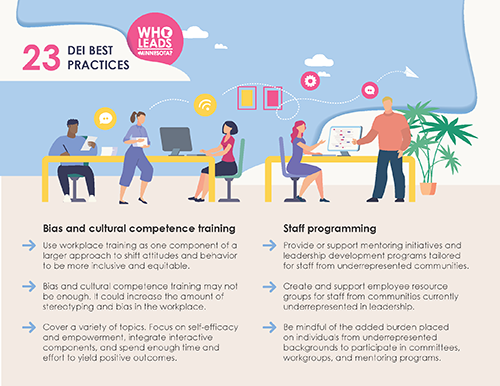What works in DEI efforts (and what doesn’t)
- Be aware that bias and cultural competence training is not sufficient. The literature is unclear about whether or not these trainings lead to shifts in attitudes or behaviors. In fact, these trainings have been found in some studies to actually increase the amount of stereotyping and bias in the workplace.
- Increase the effectiveness of trainings by covering a variety of topics, focusing on self-efficacy and empowerment, integrating interactive components, and ensuring sufficient duration and intensity to yield positive outcomes.
- Utilize training as one component of a larger approach to shifting attitudes and behavior in the workplace to be more inclusive and equitable, which could include multiple training sessions interwoven with changes in policies and practices.
- Understand that current discrimination and harassment complaint processes often do more harm than good for those lodging complaints, and that those who perpetuate discrimination and harassment rarely face consequences through these systems. Alternative options should be explored, including ombudsman programs and anonymous online complaint reporting systems.
- Define “inclusive behavior” clearly for your organization and hold staff accountable if they are not following these expectations.
- Clearly communicate the purpose of workplace policies regarding DEI efforts.
- Consider technological approaches to reducing bias in the hiring process, including hiding demographic information and names from applications. However, employers should note that technology-based strategies are often biased themselves, so proceed with caution and in an informed way.
- Utilize cluster hiring, in which multiple staff are hired at the same time. This has been found to increase diversity of new hires and reduce tokenism and stigmatization.
- Create an official policy for hiring people with disabilities, rather than relying on managers’ expressed intentions or interests alone.
- Advertise open positions broadly and place advertisements in locations that are likely to be seen by individuals from underrepresented groups.
- Be explicit about your organization’s commitment to DEI in job postings.
- Commit to proactive recruiting strategies in underrepresented communities.
- Identify clear pathways for promotion and advancement within your organization and reduce ambiguity in performance reviews and performance-based rewards.
- Provide or support mentoring initiatives and leadership development programs aimed at and tailored for staff from underrepresented communities. These programs should be complemented by continuous assessment of hiring and promotion policies and practices to identify and remove systemic barriers.
- Create and support employee resource groups for staff from communities currently underrepresented in leadership.
- Be mindful of the burden placed on individuals from underrepresented backgrounds to participate in committees, workgroups, and mentoring programs, as these often fall outside of the stated expectations for their positions and create additional work (emotional and otherwise).
- Be explicit about your organization’s commitment to DEI.
- Allocate resources, including funds and staff time, to DEI efforts.
- Prioritize relationship-building with and among staff and convey respect for and trust in their employees.
- Focus more on relational aspects of your organization’s work, promote a more collaborative than competitive culture, reward teamwork, and encourage mentorship within your organization.
- Model good work-life balance and instill an expectation that employees also adhere to a good work-life balance.
- Ensure sufficient oversight of DEI efforts and prioritize accountability and transparency.
- Identify clear and measurable goals, continuously track progress, and ensure evaluation efforts involve assessing unintended consequences of all DEI efforts.
 Download our best practices infographic.
Download our best practices infographic.